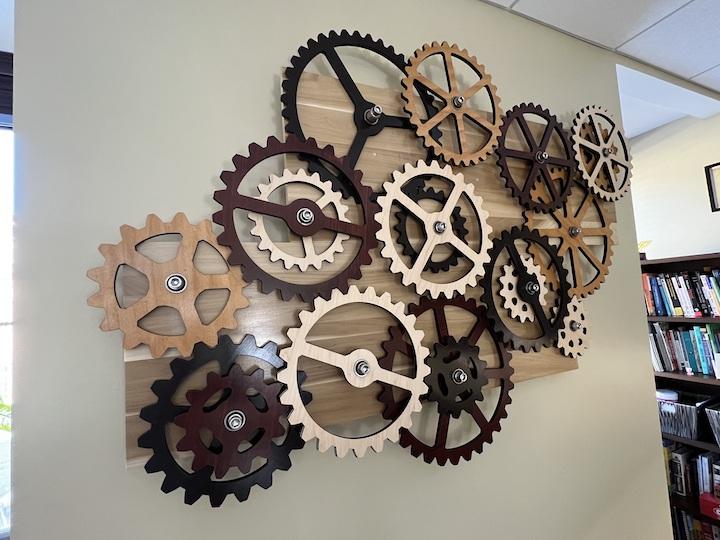The largest wall in Gina Svarovsky’s office makes a statement. Turn the first gear, and you can see what it says to you.
To Gina, an associate professor of the practice in the Notre Dame Center for STEM Education, it tells a story of solidarity.
“It’s really something about how every part of it is essential to its design. Some parts are in the foreground, some are in the background, but it doesn’t work unless they’re all working together,” Gina said. “It’s the model of partnership and equity.”
To Mark Westlake, a teacher at Saint Thomas Academy in Mendota Heights, Minnesota, who worked with Gina as a STEM Teaching Fellow, it was a statement of gratitude that he created as an engineering project with his students.
“So many things I do for professional development end up in the bottom of the file drawer, but the STEM Fellows gave me so much to use,” Mark said. “You’re always looking for ways to say thank you.”
The project started when Gina moved into a new office at Notre Dame. Faced with a large, blank wall, she wanted something interactive that was personally and professionally meaningful.
“Having worked in a museum for a while, there are a lot of interesting gear exhibits, especially in children’s museums,” she said.
So she thought of a gear installation she had seen on a visit to St. Thomas, and she turned to Mark and his class.
“I think of it as a kinetic sculpture,” Mark said. ‘It’s a project that involves a lot of engineering skills.” This was one of three capstone projects students could choose for a project called “Museum Quality Pieces.” (Other projects were an augmented reality sandbox and a Coriolis effect table.)
Like many projects the Saint Thomas team works on, they had a grand plan of sketching the design and making everything perfectly from beautiful CAD models. That plan quickly fell apart and they settled into the “Ready-Fire-Aim” approach to engineering, Mark said.
Students designed gear pairs and cut them out of paper. Once they had a mock-up of how the gears fit together, one team started staining plywood while another prepared the files for the laser cutter.
Once all the gears were cut and all the bearings were installed, the students started drilling the backboard that would hold the gears in place.
“It was a complete engineering experience for those guys,” Mark said. “It was fun to watch.”
Not everything went as planned, and more than once a hole had to be redrilled in a different location for the gears to rotate in the correct direction and without too much friction.
“They learned that failure is an important and necessary part of the engineering experience,” Mark said. “A lot of the reasons things don’t work aren’t readily apparent.”
Next up was designing and building a crate so that they could ship the gears to Gina in one piece.
“That gave the next group a different challenge,” Mark said. “Box it and make sure it’s safe when shipping it 500 miles away. I was pretty happy when Gina showed they unboxed it and it was in one piece.”
Now that the gears hang on Gina’s wall, they grab the attention of visitors and friends on Zoom calls.
“They’ll come in, and they’re not looking at me – they’re usually looking at the gears,” Gina said. “Folks want to spin it, and I say yes, you can spin it. It’s just wonder and awe.”
Mark said he and his students, who are now at work building a hydrogen fuel cell car, are thrilled that he was able to thank Gina and the STEM Center. “If you’re going to send someone a thank-you card, you want them to open it and like it,” he said.
And for Gina and those in the STEM Center, the gears are also a reminder of the impact of educators’ work.
“We can empower kids and make them understand they can be agents of change and move things forward,” Gina said. “I think that’s what inspires all of us.”
Applications for the newest cohort of STEM Teaching Fellows are now open! Click here to learn more.
 Alliance for Catholic Education
Alliance for Catholic Education
